Brief History of Lewisville
The community of Lewisville once belonged to the great desert of the Snake River Valley. Indians and trappers roamed the area, which provided an abundance of water, elk and deer who hid amongst the high sagebrush that covered the land.
From Salt Lake City settlers branched out, pushing the frontier further north into southern Idaho and on to the north side of the Dry Bed River where the first pioneers came to Poole's Island and settled at Cedar Buttes, now called Menan.
By 1881 Edmund Ellsworth's family of six children, Edmund's brother, Brigham, with five children and his sister, Luna Caroline, wife of Richard F. Jardine, and their six children all found themselves unable to support their rapidly expanding families on their twenty acres of land each family farmed. Utah's supply of land and water were limited and these families looked northward for a solution to their problem. Letters from their sister, Alice, and brother-in-law, Spencer V. Raymond, who had already settled on Poole's Island (now Menan) enticed these men to visit the area.
In 1882 the men, including John, another brother who was unmarried, contracted with the Oregon Short Line to grade five miles of railroad 41 miles west of American Falls in Southeastern Idaho. Since they were this close, they decided to see for themselves the land their sister and brother-in-law had written so much about.
On the 6th of July 1882 the men finished their contract with the railroad and set out for the Raymond Homestead. By the time they reached the south side of the Dry Bed River that July 8th, the water was too high for them to ford. Spencer V. Raymond greeted them on the opposite bank and told them, "The land on your side is just as fertile as on this side of the river." So they set up camp which was located north and east of Wells Barney's present home. However, the mosquitoes descended upon them so thick they couldn't bake their sourdough bread and care for their horses. Hurriedly they broke camp and rode their horses downriver some three miles and made camp on what is known today as Beam's Flat. Here a breeze blowing in from the river kept the mosquitoes away. By the time they'd set up a new camp they were so tired that they went to bed without anything to eat.
The next morning they had to throw away the bread they had mixed the previous night because it was covered with mosquitoes. For the next few days the men surveyed this section of land on horseback. They rode east as far as Heise Hot Springs. Returning they rode west and followed the concourse of the Snake River. The tall sage they rode through was so abundant and high that only the head and shoulders of the rider ahead could be seen. This growth indicated the richness and fertility of the soul. They came to their first camping place and staked out their claims, each taking 160 acres or a quarter of a mile by a mile section. These claims bordered to the north of the dry Bed so that each man had river ground for their cattle....
On their return home they stopped at Oxford, the county seat of Oneida, which covered everything north of the Utah border to Montana's Territory, and filed their claims. At West Weber, Utah they sold their property, packed their belongings and returned with their families, arriving at Lewisville September 9th, 1882. Edmund Ellsworth's family followed in the spring of 1883...
The townsite was surveyed by Andrew Anderson October 11 and 12, 1882 and was pretty well laid out the way it is today. Some of the early settlers lived in town and commuted to their farms....
As soon as the settlers had completed their homes, they started building a 20 X 30 foot log building to be used for the community as a school, church and other social functions. It was erected just south of the Lewisville store where the rock house now stands. Each man had to furnish a log for this building. It was started December 3, 1883 and was completed January 8, 1884. Then a celebration was held January 23, 1884....
Early pictures from the Village of Lewisville




